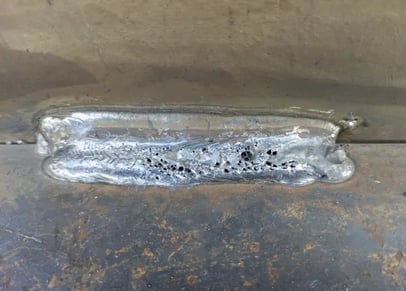What is Porosity in Welding: Common Sources and Effective Solutions
Porosity in Welding: Identifying Common Issues and Implementing Ideal Practices for Prevention
Porosity in welding is a pervasive issue that often goes undetected up until it creates substantial troubles with the honesty of welds. In this conversation, we will check out the key elements contributing to porosity formation, examine its destructive impacts on weld efficiency, and review the ideal methods that can be taken on to decrease porosity occurrence in welding procedures.
Common Causes of Porosity

One more frequent offender behind porosity is the visibility of contaminants on the surface of the base steel, such as oil, grease, or rust. When these contaminants are not effectively eliminated before welding, they can evaporate and come to be trapped in the weld, triggering issues. Using filthy or wet filler products can present pollutants right into the weld, adding to porosity concerns. To mitigate these typical sources of porosity, extensive cleansing of base steels, correct shielding gas option, and adherence to optimum welding parameters are essential practices in accomplishing high-grade, porosity-free welds.
Impact of Porosity on Weld Quality

The visibility of porosity in welding can considerably jeopardize the architectural stability and mechanical residential properties of bonded joints. Porosity produces voids within the weld steel, weakening its general strength and load-bearing capability.
Welds with high porosity levels often tend to show reduced effect strength and reduced ability to flaw plastically prior to fracturing. Porosity can impede the weld's ability to properly send forces, leading to premature weld failing and prospective security hazards in critical frameworks.
Finest Practices for Porosity Prevention
To boost the structural integrity and top quality of welded joints, what details steps can be implemented to lessen the occurrence of porosity throughout the welding procedure? Making use of the correct welding strategy for the specific material being welded, such as adjusting the welding angle and weapon position, can additionally prevent porosity. Routine examination of welds and instant removal of any concerns recognized during the welding procedure are necessary techniques to avoid porosity and generate top quality welds.
Relevance of Proper Welding Methods
Applying proper welding methods is extremely important in making sure the structural honesty and high quality of welded joints, constructing upon the structure of effective porosity avoidance procedures. Welding methods straight impact the overall toughness and durability of the bonded framework. One essential element of proper welding methods is preserving the proper warmth input. Excessive heat can result in boosted porosity because of the entrapment of gases in the weld swimming pool. Conversely, not enough warm might cause insufficient fusion, creating potential powerlessness in the joint. Furthermore, utilizing the suitable welding specifications, such as voltage, present, and take a trip speed, view it now is vital for achieving sound welds with minimal porosity.
Furthermore, the option of welding process, whether it be MIG, TIG, or stick welding, need to align with the certain requirements of the job to make certain optimal outcomes. Correct cleansing and prep work of the base metal, as well as choosing the right filler material, are additionally vital parts of skilled welding strategies. By adhering to these ideal techniques, welders can minimize the danger of porosity formation and generate high-grade, structurally sound welds.

Evaluating and Quality Assurance Actions
Testing treatments are crucial to discover and protect against porosity in welding, making sure the toughness and sturdiness of the last product. Non-destructive testing techniques such as ultrasonic screening, radiographic testing, and visual inspection are commonly used to recognize possible flaws like porosity.
Conducting pre-weld and post-weld evaluations is likewise vital in maintaining quality assurance requirements. Pre-weld evaluations entail confirming the products, tools setups, and cleanliness of the job area to avoid contamination. Post-weld assessments, on the other hand, analyze the final weld for any kind of problems, consisting of porosity, and more helpful hints verify that it fulfills specified criteria. Executing a detailed quality control strategy that includes complete testing treatments and inspections is paramount to reducing porosity issues and making certain the total high quality of welded joints.
Conclusion
Finally, porosity in welding can be an usual problem that impacts the top quality of welds. By determining the common reasons of porosity and executing finest methods for avoidance, such as appropriate welding strategies and screening measures, welders can guarantee premium quality and trustworthy welds. It is vital additional info to prioritize prevention methods to minimize the occurrence of porosity and maintain the integrity of welded frameworks.